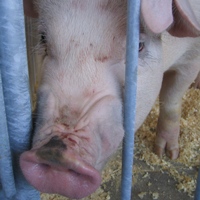Canadian pig numbers continue to fall

The latest Canadian livestock census, published in August, shows a continuing decline in the pork industry, with the number of farms with pigs falling 19% between July 2007 and the same month in 2008.
Biggest losers were the western provinces of Saskatchewan, with a 30% reduction and Alberta with 24%. There were 11.6% fewer pigs in total, although the number of breeding pigs fell by just 4.6%.
The figures also reflect an increasing trend towards shipping weaned pigs or feeder pigs to the USA, with finishing pigs over 60 kg down by 15%. However, following a record first quarter for live exports, when an estimated 2.9 million pigs moved to the USA, the second quarter numbers were put at 2.2 million by Statistics Canada.
Incentive
The drop in breeding pig numbers was lower than expected, bearing in mind the financial incentive to reduce the national herd size provided by the federal Cull Breeding Swine programme.
Producers who depopulate breeding barns and agree to leave them empty for three years qualify for payments of CAN$225 per culled animal.
After the programme was launched in April, uptake was good and by July had passed 100,000 but, since then, interest seems to have been lower. Martin Rice, executive director of the Canadian Pork Council, which administers the scheme, believes the key element that has discouraged participation is the obligation to leave the barn closed for three years.
Less attractive
“As well, improved returns over the past few months through the commercial market have made the $225 payout, with its conditions, less attractive,” he says. He notes that many producers are reducing their numbers without going through the programme and without emptying entire barns or obligating themselves to leave space empty.
The objective of the programme is to reduce breeding stock numbers by about 150,000 sows, or 10% of the national herd, but it seems likely that the eventual figure will be nearer to 120,000.
Human food chain
Carcasses from the culled animals have to be kept out of the human food chain, both in the domestic and export markets. However, concerned about the public reaction to destroying perfectly good pork, and in response to producer comments, provincial pork organisations persuaded the federal government to allow the meat to be donated to local food banks.
For example, in Saskatchewan, about 2,000 sows were diverted from the cull programme and processed to produce 500 thousand pounds of meat, which went to food banks across the province as well as associated agencies.
The $440,000 cost of processing was borne by the provincial government. Similar schemes have been initiated in Alberta, Manitoba, Ontario and Quebec.
Click here to receive the free Pig Progress newsletter











